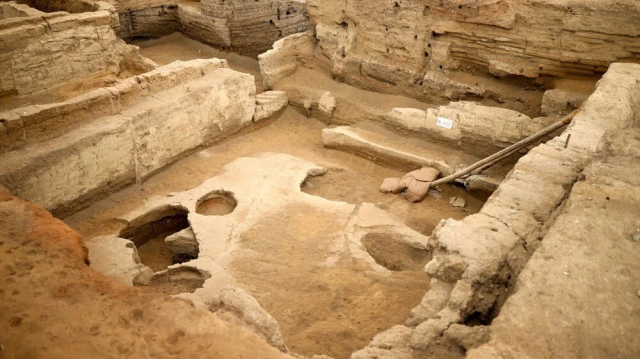
An 8,600-year-old piece of bread has been found in a structure resembling an oven in Catalhoyuk, south-central Türkiye, one of the first places in the world where urban settlement has been recorded.
Located in the Cumra district of Konya, Catalhoyuk, where approximately 8,000 people lived together during the Neolithic period, a structure resembling an oven was discovered in an area known as "Space 66," characterized by adobe houses with interconnected roofs accessed from above.
Near the severely damaged oven, a palm-sized artifact was found containing wheat, barley, and pea seeds, likely used for food.
Analyses conducted at the Science and Technology Research and Application Center (BITAM) of Necmettin Erbakan University in Konya revealed that the spongy residue identified as leavened bread dates back to 6600 BC.
Ali Umut Turkcan, Head of the Excavation Team at Anadolu University, told Anadolu that "archaeology" often brings structures, monuments, and artifacts to mind.
Turkcan noted the emergence of food archaeology within modern archaeology, emphasizing Anatolia's significance, particularly Catalhoyuk.
He highlighted the discovery in 2021, showcasing Turkish excavations' ability to identify organic residues through "meticulous documentation and detailed studies."
He highlighted Catalhoyuk Neolithic City's importance by stating, "With meticulous documentation, we identified the small, round, spongy artifact found in the oven corner as bread. The thin clay covering preserved wood and bread, allowing all organic residues to endure. Radiocarbon tests at TUBITAK Marmara Research Center (MAM) suggested our sample could date back to around 6600 BC."
- Oldest bread in the world
Turkcan mentioned that the earliest examples of leavened bread were found in Egypt.
He said, "We can say that this finding in Catalhoyuk is the world's oldest bread. Considering observations, analyses, and dating, we estimate this organic residue to be approximately 8,600 years old.
"It's a miniature version of a loaf of bread. It hasn't been baked in the oven but has fermented, preserving the starches. Such an example hasn't existed until now. Catalhoyuk has always been the center of many firsts.
"Even in its early excavation years, the world's first textiles were found here. Wooden artifacts were also discovered in Catalhoyuk. This adds to the wall paintings and drawings. In this regard, Konya and Türkiye are very fortunate."
Turkcan emphasized the importance of analysis studies, noting that the university's laboratories' capability to conduct all analyses is a "significant advantage."
He also highlighted the significance of this capability being established for the first time in Turkish laboratories.
- Cereal residues excites
Salih Kavak, a lecturer at Gaziantep University, expressed excitement for his contribution to the analysis and evaluation of the "Catalhoyuk Space 66 Neolithic Period Bread Discovery," stating it's the most exciting study in archaeo-botany to date.
Kavak recounted being informed of the organic discovery while examining plant residues in the laboratory.
He expressed surprise upon receiving it, initially pondering whether such a form could indeed be "dough, bread, or an organic residue.""Upon a visual morphological diagnosis and subsequent microscopic examination, the most exciting aspect was the presence of cereal residues," he stressed.
Adding that the discovery of ground or broken pieces belonging to plants like barley, wheat, and peas "immediately strengthened" the possibility of it being bread.
Kavak highlighted the need for chemical and physical analyses of the discovery to confirm their hypothesis.
He stressed that directed to BITAM for analysis by Oguz Dogan, a detailed examination, including SEM images, revealed air pockets and plant residues.
"Chemical analyses indicated signs of fermentation, suggesting the mixture had been prepared but not baked," he said.
Kavak concluded that this "unprecedented discovery" marks the oldest known bread-like specimen, sparking excitement in Türkiye and worldwide.
BITAM's Deputy Director, Yasin Ramazan Eker, told Anadolu that he emphasized the center's capability to analyze archaeological findings and noted that they "could determine the chemical and physical structures of samples and interpret their significance."
"With advanced technology, we could conduct these analyses at the BITAM central laboratory, leading to more accurate diagnoses," he said.
He added that the discovery of an 8,600-year-old bread residue at Catalhoyuk raised suspicions, which were confirmed through the analyses, indicating the sample's unbaked nature.













